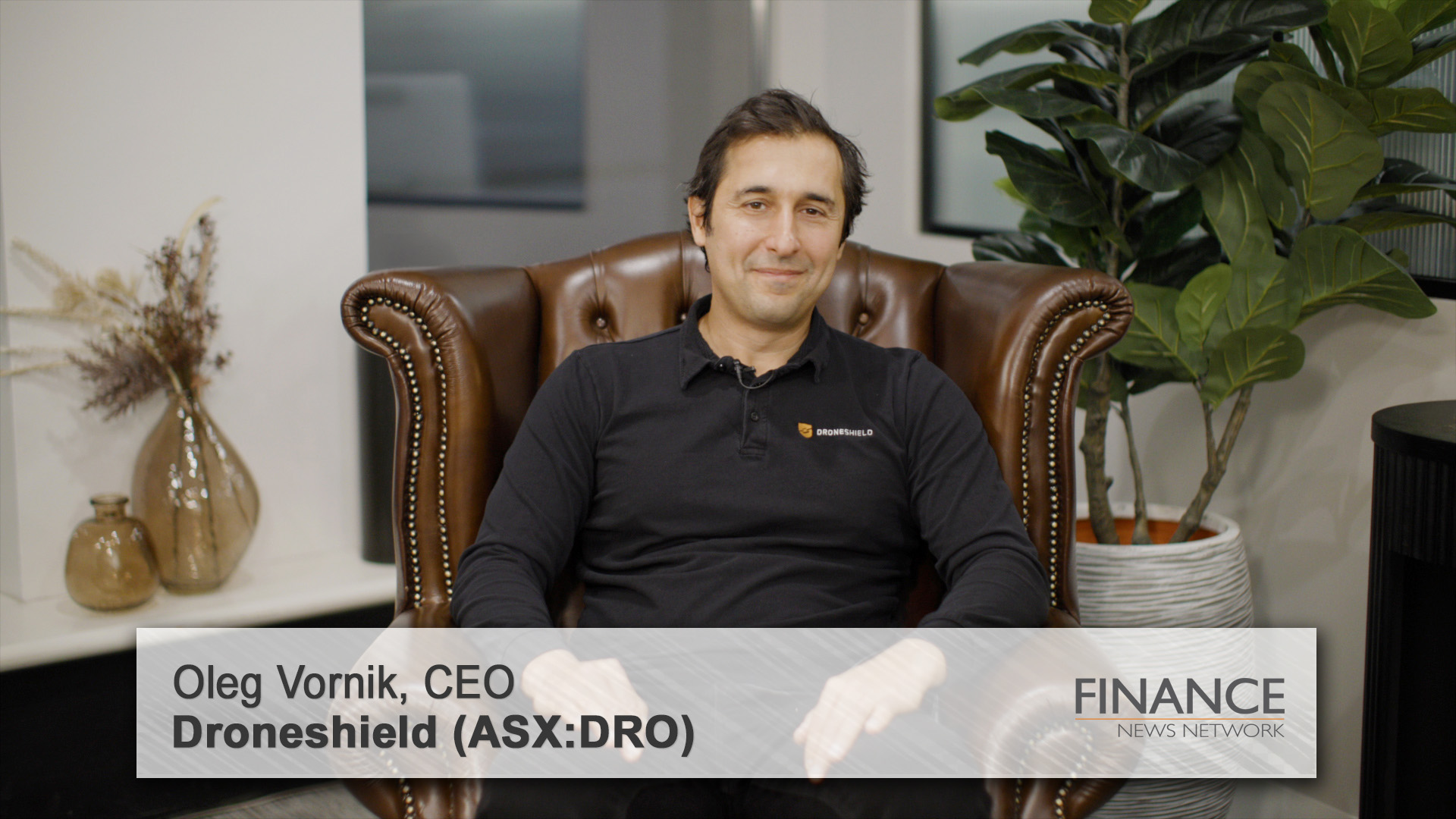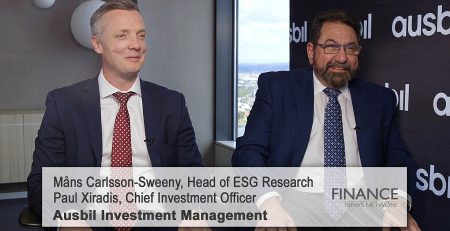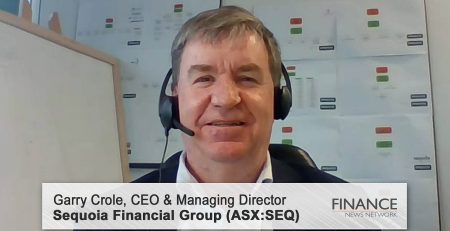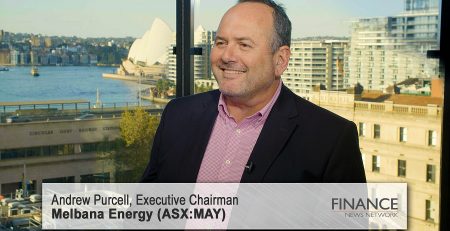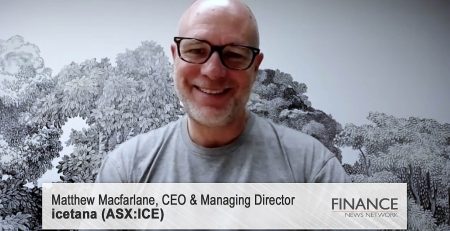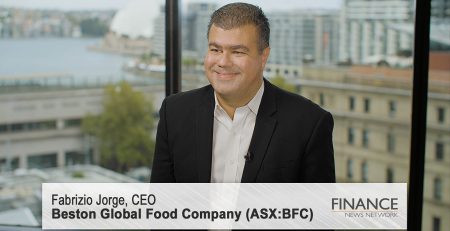Droneshield’s CEO on surging share price and expanding global markets
Peter Milios: I'm Peter Milios from the Finance News Network and today we're talking with DroneShield. DroneShield is trading under the ASX code DRO and has a market capitalization of approximately 1.5 billion. DroneShield or DRO is an Australian defense manufacturer specializing in counter drone technology. Today we're pleased to have with us DroneShield's CEO and managing director Mr. Oleg Vornik. Oleg, welcome back to the Network.
Oleg Vornik: Thanks for having me.
Peter Milios: So Oleg, before we get into the operations of the business, I just want to touch on DroneShield's share price. It's surged massively. I think it's up over 400% year to date and over 700% over the past year. I just wanted to get your thoughts as to why you think the share price has surged so much so quickly.
Oleg Vornik: For years, the business has been rapidly developing, but the share price has not been reflecting, to our great frustration. And then what we're finding that may over the last six, 12 months, we're seeing a lot of making up for it. So it has been really rapid appreciation, but in our minds the valuation makes sense because there's been really no change in the years prior to that as a lot of hard work was put in and then the results were coming in. So that's my view on it.
Peter Milios: Okay, thank you. So now shifting to operations, can you paint a bit of a picture as to what DroneShield does and how it makes money?
Oleg Vornik: DroneShield makes counter drone hardware and software, so small drones being used by bad guys for terrorism, warfare, sending drugs across borders, delivery of contraband to prisons. DroneShield uses mostly radiofrequency, but also radar camera and acoustic technologies to detect, track and then use smart jamming to defeat drones. So by defeat, we neutralize the connection between the drone and the outside world and the drone responds by lowering itself on the ground. A swarm of drones can be defeated in the same way.
So we have three families of products. Handheld systems, detection and defeat, on the move or vehicle-based systems and fixed site systems. The price brackets are from tens of thousands US dollars for the handheld systems to hundreds of thousands for the on the move to … It's quite module… our fixed site systems from hundreds of thousands to over a million bucks per system.
Peter Milios: So just on that, the hardware, just to summarize, the hardware consists of handheld, on the move, and fixed site. However the other streams of revenue is the SaaS component and the R&D component. Can you explain those in a little bit more detail?
Oleg Vornik: Every product except the drone guns and drone guns we expect from next year as well, has quarterly SaaS subscription. So our artificial intelligence firmware getting updated every quarter to be able to detect never-seen- before drones even better because you have thousands of new drone types coming out every year. So technology advances really quickly.
And by the way, we do hardware refreshes every couple of years as well. The customers pay for. So then customers pay for SaaS, it's priced at about 10 cents for every dollar in purchase price, and then there is long-term contracts. We have a two-year $10 million contract with the Australian Department of Defense that is in style of technology very much in synergy with our main counter drone business and we expect for that to grow. So electronic warfare.
Peter Milios: So you did touch on the fact that you want all products to occupy that SaaS system. How do you feel that benefits you guys?
Oleg Vornik: Hardware sales are lumpy. SaaS gives you that smoothing out and of course the margins are even better. Our hardware sales enjoy really high margin off the back of high differentiation of our products and investment in the technology we make. But software naturally has even higher profitability base because you don't have to actually build the hardware in terms of what you sell.
So we feel that the goal is in the next five years to have close to half of the revenues coming from SaaS and our research contracts which are software based, which will continue lifting up our margins.
Peter Milios: Let's talk about the sectors that you occupy in. Obviously you're massively hedged to defense. Can you paint some more color about that, but also the other sectors you provide too?
Oleg Vornik: Drone threat is very new. Drones have not even existed 10 years ago. So militaries tend to be first adopters of new technology. You think of internet, for example, first being used by the military and then flowing into civilian applications. So we're seeing militaries now use our technologies all over the world. US military is our largest customer. We in fact are embedded with every branch of US military apart from US Space Force and we'll probably get to the Space Force eventually. But then in the US we also work in VIP protection, parts of US military, border security intelligence, law enforcement and others.
And then all over the world we're present in about 70 countries around the world. Like for example, work with UK military, French military, of course here with Australian military and then New Zealand military as well. And then outside of militaries, we believe that over time, the civilian markets like protection of stadiums, prisons, airports, critical infrastructure will open up and be a very significant revenue driver.
Peter Milios: So other than defense, can you go in a bit of more detail as to which sectors you think DroneShield will occupy within and it'll make up a larger portion of revenue moving ahead?
Oleg Vornik: Airports is expected to be a very large sector. Drones present significant threat to aircraft. Unlike birds, if a drone gets ingested into the jet engine, it has strong likelihood of blowing it up because drones have metal parts and lithium-ion batteries inside and that might potentially down the airplane and have large loss of life.
So today, when there are drones that enter airports, all flights have to be stopped. Significant cost, inconvenience. But of course the ultimate problem would be if a drone is not detected, and today vast majority of airports are completely unprotected, detection of or defeat for drones, and then you're going to have that mass loss of life. So we think airports would be a very large sector for DroneShield.
Prisons is another, so people delivering Amazon-style drugs, weapons, cigarettes, escape kits, handguns to prison windows. In the stadiums you imagine people doing terrorist attack or even potentially spraying white powder, creating panic around those. Other critical infrastructure like ports, maybe power grids. So all of those. You can think of drones ultimately as a platform and you can adapt that platform for whatever missions you'd like. So surveillance, delivery of payloads, all of that drones are really good at.
So today for vast majority of civilian targets, or virtually all of them in fact, when you're a bad guy with a drone, you can fly and you know that you are completely safe, because worst case scenario, you lose your drone, probably nobody will ever find out you've even been flying the drone. So drones are very effective ways of doing things and guys who are trying to do nefarious missions.
Peter Milios: And what's the biggest threat to DroneShield?
Oleg Vornik: Technology evolution. So we're not concerned about competition. Over the years, we're the first mover in this industry from a decade ago. We have a strong team of engineers, strong sales team, exceptionally strong sales team across US, Australia, Europe, and growing. But the evolution of technology and drones themselves will be a critical thing for us. We cannot provide, and neither does anybody else, absolute 100% of protection. Our saying goes, counter drone systems are a bit like fences. People cut holes in fences, people can fly over fences, but you still want them because it means that 99% of drones cannot get through your systems and the enemy has to spend more effort in trying to get around it.
But we are seeing new technologies over the horizon, which is also why we're having over 100 engineers and our team of people, 150 people, and rapidly growing hardware, software. We don't rely on any third party IP. We do everything ourselves.
That enables us to develop our technologies even faster, both hardware and software. So for us, the main challenge is keeping up with that small drone technology as Russian, Chinese and other governments are continuing to fuse military technologies into small drones and making them more difficult to detect, more difficult to avoid.
From customer point of view, I believe customers will continue to buy counter drone systems even if they may be not absolutely 100% proof. The idea is you want to be better than your competitor and continue to invest in evolution of your technology.
Peter Milios: Now on your customers, your biggest customer is the US. How do you foresee that in the future?
Oleg Vornik: US will always be our biggest customer. US is the largest spend in the world in terms of military and security items. And this is not just the military, airports in the US or prisons and so on. It's the largest target in terms of being a customer for anybody globally. So for us it'll be as well. But we're in 70 countries around the world. So today we are busy establishing our own sales teams. We're not doing shiny offices. It's basically senior sales guys going to the customers in Europe, in South America, in Middle East, in addition to our Australian US sales office base and then pursuing those customers.
So we already have sales to the likes of the UK Ministry of Defense, the French military, Brazilian military, Indonesian military and so on. And we will continue to build on those.
Peter Milios: Oleg, thank you for your time.
Oleg Vornik: Pleasure.
Ends
Copyright 2024 – Finance News Network
Source: Finance News Network

